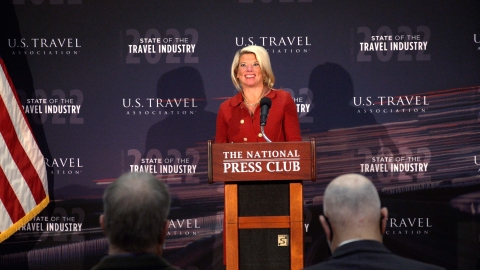U.S. Travel Sets Future-Forward Recovery Plan, With Business Travel and Events Top-of-Mind

U.S. Travel Association leaders outlined a path forward during the organization’s annual State of the Industry Address on Feb. 2, which highlighted the progress made since March 2020, while emphasizing critical areas of importance to fully recover to pre-pandemic levels—including business travel and face-to-face events.
“The worst of the pandemic is truly behind us, but there is a lot of work ahead,” said U.S. Travel President and CEO Roger Dow, underscoring the $730 billion in cumulative travel spending losses since the pandemic began.
While the domestic leisure travel segment has largely recovered with the surge in demand after the deployment of vaccines last year, business travel and professional meetings and events, in addition to international inbound travel, are lagging behind, according to Dow.
“Business travel makes up a significant portion of the overall travel economy—without it, we cannot fully recover,” he said. “And international inbound travel is a necessity for a complete and even recovery of the U.S. travel economy.”
Economists estimate that domestic business travel and international inbound travel may not fully recover until 2024, according to Dow.
“We should not singularly view the pandemic as a setback but as an opportunity to reimagine this industry to be stronger than before,” he added.
Robust Plan for Growth and Recovery
U.S. Travel’s strategy to look beyond the pandemic and ensure the growth and even recovery across all segments of the industry includes the following initiatives:
- Strengthening the travel workforce and restoring millions of lost jobs
- Creating a more seamless and secure travel experience
- Shaping the future of travel mobility
- Focusing on sustainability to grow the industry responsibly
- Focusing on diversity, equity and inclusion within the industry
- Continuing to rebuild international inbound travel, business travel and professional meetings and events
Dow outlined short-term priorities that the U.S. Congress and the Biden Administration should act upon immediately. The initiatives include the passage of the Restoring Brand USA Act, which would provide emergency relief funding and be especially important in rebuilding global market share following the steep pandemic setback in inbound travel; providing targeted temporary tax credits and deductions to stimulate spending on business travel, live entertainment and in-person events; and providing additional funding for relief grants to the most severely impacted travel businesses.
“We are also calling on business leaders to take a real look at the importance of business travel to productivity and success, as well as opportunities that come from meeting face-to-face, getting deals done and the value employees place on being able to get together in person,” Dow said, calling attention to the association’s Let’s Meet There initiative.
Meanwhile, U.S. Travel Executive Vice President of Public Affairs and Policy Tori Emerson Barnes offered remarks on the future of a rapidly evolving travel industry and keeping business travel and events top-of-mind in the overall strategy.
“We have strengthened our relationships with industry-leading coalitions, including the Meetings Mean Business coalition, which is now fully integrated into U.S. Travel,” Barnes said.
She emphasized the importance of continuing to promote the fact that in-person meetings and events are being held safely in destinations throughout the U.S.
“We just went through a paid media campaign with our Let’s Meet There coalition that was really targeted at business leaders across the country who are making decisions on whether or not their employees can travel,” Barnes said. “We'll also be highlighting Global Meetings Industry Day, which will take place on April 7, and we'll be doing a roundtable with elected leaders on that day as well.”
In other aspects of U.S. Travel’s plan for the future, Barnes said it forged a partnership with Tourism Diversity Matters as part of its diversity, equity and inclusion initiative to create an industry that works for and benefits everyone.
“But the future of our association and our industry depends on our ability to grow, diversify and support sustainably,” she added.
With that in mind, Barnes pointed to U.S. Travel initiatives such as The Future of Travel Mobility program, which was held in Washington, D.C., last October. The event brought industry leaders together to focus on the intersection of travel, transportation and technology, with conversations around sustainability, seamless and secure travel and innovative and emerging travel technologies such as the hyperloop and high-speed rail, as well as improving the nation's airports.
“U.S. Travel is working to ensure the federal government moves quickly to facilitate the adoption of sustainable aviation fuels, and perhaps most importantly, given the majority of trips are taken by car, it is imperative that we ensure electric vehicle infrastructure is deployed,” she said. “This is crucial to growing our industry and protecting the planet while also keeping customers at the forefront.”
The recovery of the industry overall, particularly as it relates to the U.S. economy, depends on U.S. Travel’s vision and strategy, Barnes added.
“We must not only continue to engage on these issues, but we will [also] lead on these priorities, which will strengthen our industry as we speak with one voice to restore the backbone of our nation's economy to its pre-pandemic highs and beyond,” she said.
Photo: U.S. Travel Executive Vice President of Public Affairs and Policy Tori Emerson Barnes
Don’t miss any event-related news: Sign up for our weekly e-newsletter HERE and engage with us on Twitter, Facebook and LinkedIn!


Add new comment